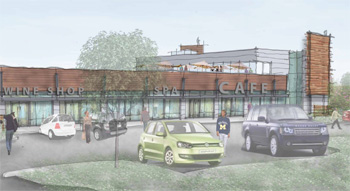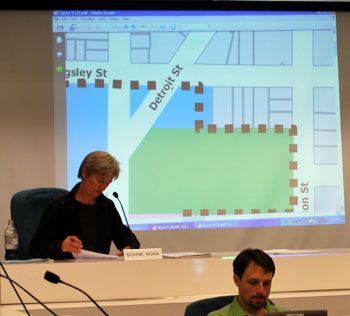Shaping Ann Arbor’s Public Art Landscape
Ann Arbor public art commission retreat (Feb. 26, 2012): At a four-hour retreat on Sunday, the nine-member public art commission began developing a master plan to guide the allocation of Ann Arbor’s Percent for Art funds and the selection of future public art projects.

Ann Arbor's public art administrator, Aaron Seagraves (center) talks with public art commissioners Wiltrud Simbuerger and Bob Miller at the commission's Feb. 26, 2012 retreat. The four-hour session was held at the NEW Center on North Main. (Photos by the writer.)
The Percent for Art program, overseen by AAPAC, allocates 1% for public art from all of the city government’s capital projects. The program faced potential cuts by the city council last year, though a majority of councilmembers ultimately voted against decreased funding. There’s also been criticism that the commission, which was formed in 2008, has been too slow in funding works of art. The commission itself has seen recent turnover, with three new commissioners appointed since late 2011.
It’s in this context that AAPAC decided to work on a master plan – the retreat was a step toward that goal, though it’s expected to take several more months to complete. Meanwhile, the commission is also preparing an annual plan to approve at its next meeting, on March 28, with a list of specific projects it intends to pursue in the coming fiscal year. The public art ordinance requires that the annual plan be submitted to the city council by April 1.
Sunday’s retreat covered a broad range of topics. Commissioners discussed the need to address all aspects of their mission, as spelled out in the ordinance – including education, outreach and promotion of public art. John Kotarski, one of the newest commissioners, proposed a motto to reflect that goal: “The educated resident is the best consumer of public art.”
Questions were raised about whether Percent for Art funds could be used for outreach and promotion – in the past, AAPAC has been told by city staff that funding is restricted to permanent capital projects. Kotarski advocated for including temporary projects, such as an artist-in-residence program or events like FestiFools. If the ordinance doesn’t currently allow temporary work, he suggested amending it.
When Kotarski urged the commission to seek clarity from the city attorney’s office, Tony Derezinski – a commissioner who also serves on the city council – said the city attorney’s staff is already working on legal opinions related to questions from councilmembers. He indicated that the legal staff would be willing to attend a future AAPAC meeting to answer these questions.
Also during the meeting, Aaron Seagraves, the city’s public art administrator, presented preliminary results of an online survey of residents, which yielded 437 responses. [.pdf of preliminary survey report] In response to one of the questions – “Where are the public places in the city that would benefit from a public art project?” – the top three responses were parks (27 responses), “none” (25 responses) and Main Street (23 responses.)
Other items emerged at the retreat. Theresa Reid, the newest commissioner who was appointed earlier this year, reported that she and others are working to apply for a National Endowment for the Arts “Our Town” grant, to help pay for a countywide public arts planning process. Derezinski indicated that the Detroit Institute of Art’s Inside|Out project, which involves installing framed reproductions from the DIA’s collection at outdoor locations on building facades or in parks, likely won’t come to Ann Arbor until 2013. When originally proposed in October 2011, it was expected to take place this year.
Another possible project on the horizon is tied to the resurfacing of Main Street in 2013. AAPAC chair Marsha Chamberlin said the Main Street Area Association and Downtown Development Authority are interested in some kind of “street stamping” project. It’s a project that’s in the very early stages, she said, but might include ideas like creating patterns on the street at crosswalks, for example.
Though discrete projects were mentioned, the focus of the retreat remained on big-picture goals. Common themes included the importance of public art in creating a sense of identity for the community, and of its role in supporting the local economy. [Full Story]








